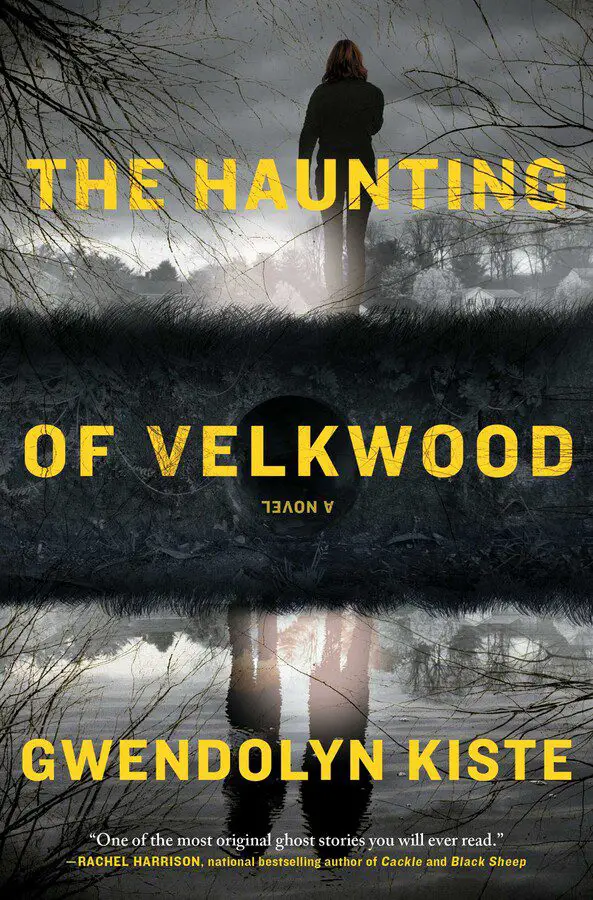Talitha Velkwood hasn’t been home in 20 years. That’s easy to avoid when your home, your neighbors’ homes, and your street are gone. Even easier if you’re one of three people who didn’t disappear along with it. But going home is exactly what Talitha is going to do. Arriving March 5th from Saga Press, Gwendolyn Kiste’s newest release is an expansive take on one of horror’s most classic subgenres. The Haunting of Velkwood is not a haunted house—it’s a haunted street.
The Velkwood Vicinity is a supernatural phenomenon. One day, it was a normal street. The next, it was a ghost. When I read a haunted house story, I’m always looking for the house to be its own character. Sure, I’m interested in the ghosts, too. Who isn’t? But when the setting is done right, the house comes alive. By having the entire street, houses and all, become a ghost, Kiste checked that box for me immediately. And then some.
The questions I asked myself while reading took on new shapes. It wasn’t just, “What happened here?” It was, “What happened here that could cause all of this?” It has to be big, right? That’s the thing about a haunting—it’s personal. But not in Velkwood. In Velkwood, it’s streetwide. And while I asked, “Why?” I also had to ask, “How?” How does something like this happen? What are the implications of something like this? You can’t hide it; it’s not an urban legend. You can’t walk that street. People didn’t leave.

I wasn’t the only one asking these questions. Talitha, along with her fellow survivors and former friends Brett and Grace, became minor celebrities. How did they get out? Do they know what happened? Will they go back? It’s that last question that starts this book. Those three are the only ones able to enter the Velkwood Vicinity. Grace has actually been back. But she won’t go, now. And neither will Brett. So when a researcher, flush with grant money, knocks on Talitha’s door—she’s the last chance. And she says yes.
One of the coolest choices Kiste made is that the Velkwood Vicinity isn’t just a haunted place. It’s a haunted time. What that researcher is asking Talitha to do is re-enter her past. That’s a step beyond simply facing it. The time aspect creates an emotional tide beneath the mystery. We aren’t simply finding out what happened twenty years ago; we’re living it. That looking back, the nostalgic lens is quickly becoming one of my favorites in horror. When done well, it can pack a gut-wrenching punch. It’s done well, here.
And of course, it’s not just the place that’s from the past. Brett and Grace are, too. Talitha and Brett’s relationship in particular is one of the strongest threads in Velkwood. Losing the closeness you once had with someone is a particular kind of pain. The person isn’t what is gone, just the way you used to exist together. It’s complicated. It’s messy. It hurts. I won’t assume every reader has experienced this. But I don’t think the poignancy will be lost if you’ve been lucky enough to avoid it. And these two aside—all three girls lost their families. That’s another level of complicated entirely. And with that, so much more grief.
I really loved this book. The voice and tone was, in my opinion, perfect. If it wasn’t an advanced reader’s copy, I could have filled this review with quotes. This was my first read from Gwendolyn Kiste, so I’m not sure if she is always this quotable, but I definitely intend to find out. Most importantly, this fit what I’m wanting out of horror these days. Horror, to me, is about more than the scares. It’s the whole range of human emotion, especially the harder ones. The Haunting of Velkwood hits that ghostly nail on its ghostly head.
The Haunting of Velkwood is available March 5, 2024.
Photo courtesy of Saga Press.
Have strong thoughts about this piece you need to share? Or maybe there’s something else on your mind you’re wanting to talk about with fellow Fandomentals? Head on over to our Community server to join in the conversation!

